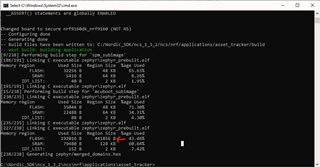Hi team,
I am working with nRF9160DK on NCS v1.3.2.
I am building the asset_tracker application and from my understanding when running running west build -b nrf9160dk_nrf9160ns, it is building 3 hex files that are subsequently merged: spm, mcuboot, and zephyr (which is the application).
From the build output, the region size for the application is 441856B (0x6be00). Which file inside the SDK do I need to open to modify this? Let's say I want this to be 524288B (512kB). Where do I set this?
I see that after building a project, inside the build folder, I have partitions_nrf9160dk_nrf9160.yml and pm_nrf9160dk_nrf9160.config which mention 0x6be00 but where is that number being pulled from? Can you help me understand how this partitioning is related to/different from the partitions in zephyr\boards\arm\nrf9160dk_nrf9160\nrf9160dk_nrf9160_partition_conf.dts?
Also, why does the region for the SPM + MCUboot + Application not equal 1MB? What is the rest of the space doing?

Regards,
Akash Patel
